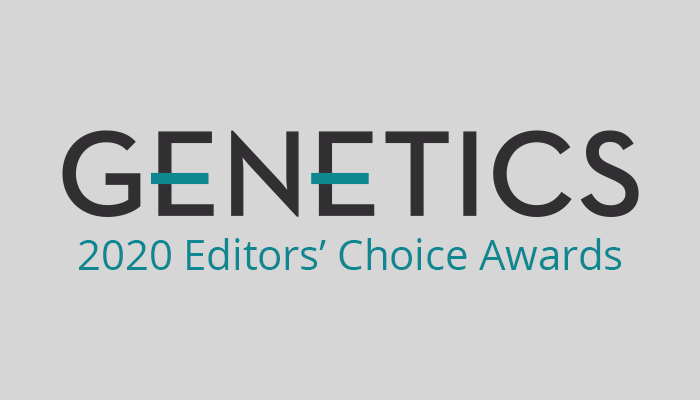Congratulations to the winners of the Editors’ Choice Awards for outstanding articles published in GENETICS in 2020! The journal’s Editorial Board considered a diverse range of articles, finding many papers worthy of recognition. After much deliberation, they settled on one exceptional article for each of the three award categories: molecular genetics, population and evolutionary genetics, and quantitative genetics. Check out some of the best GENETICS had to offer in 2020, and be sure to browse the full Spotlight collection.
EDITORS’ CHOICE AWARD IN POPULATION AND EVOLUTIONARY GENETICS
Zachary L. Fuller, Spencer A. Koury, Christopher J. Leonard, Randee E. Young, Kobe Ikegami, Jonathan Westlake, Stephen Richards, Stephen W. Schaeffer, and Nitin Phadnis
GENETICS Sep 2020 216: 205-226
The Drosophila pseudoobscura Sex-Ratio (SR) chromosome was one of the first-discovered segregation distorter chromosomes. Despite being a historically significant and well-studied system, the mechanisms allowing for the long-term association of the SR chromosome with multiple nonoverlapping inversions remain unclear. Fuller, Koury et al. perform a comparative study of SR and uninverted standard X- chromosomes in D. pseudoobscura to study the evolutionary history and dynamics of SR chromosomes. Combining the genomics analysis, direct recombination experiments, and population genetic modelling, they demonstrate that SR chromosomes are maintained through a combination of suppressed recombination and epistatic selection.
EDITORS’ CHOICE AWARD IN MOLECULAR GENETICS
Mark Hintze, Sneha L. Koneru, Sophie P. R. Gilbert, Dimitris Katsanos, Julien Lambert and Michalis Barkoulas
GENETICS Apr 2020, 214: 927-939
Developmental phenotypes are often consistent across individuals within a population in the face of environmental and genetic challenges. However, these challenges can exceed the level of system robustness and change developmental outcomes. Hintze et al. use a set of epidermal stem cells in Caenorhabditis elegans to investigate cell fate patterning in response to changes in temperature and genetic background. They find that asymmetric cell divisions shift to symmetric upon temperature increase through changes in the Wnt asymmetry pathway activation. Furthermore, different genetic backgrounds show varying degrees of sensitivity to cell fate errors upon temperature increase.
EDITORS’ CHOICE AWARD IN QUANTITATIVE GENETICS
Alice H. MacQueen, Jeffrey W. White, Rian Lee, Juan M. Osorno, Jeremy Schmutz, Phillip N. Miklas, Jim Myers, Phillip E. McClean and Thomas E. Juenger
GENETICS May 2020 215: 267-284
The Cooperative Dry Bean Nursery has produced a multi-environment phenotype dataset with thousands of phenotypic datapoints measured over many decades. To study stable genetic effects in this dataset, MacQueen et al. conducted a genome-wide association using best linear unbiased predictions derived across years and locations for 21 phenotypes, using genotypic data (1.2M SNPs) for 327 genotypes. They find significant effects for all phenotypes, two genomic regions with significant effects on many phenotypes, and multiple genomic regions previously identified in other genome-wide association work in common bean. Their results demonstrate that multi-environment datasets not designed for genetic work can nonetheless support genetic discovery.































